Two Keys To Understanding The Earth --
The Energy of Earthquakes, and the Cause of Expansion
David Noel
<davidn@aoi.com.au>
Ben Franklin Centre for Theoretical Research
PO Box 27, Subiaco, WA 6008, Australia.
What we know about the Earth
Our knowledge of the physical Earth upon which we live has been advancing since scientific enquiry began. But there have been some puzzles not resolved.
In recent years, two new models have come forward which finally give an explanation of some of the most difficult puzzles. These are on the energy of earthquakes, and on the cause of expansion of the Earth.
Topic 1. The Energy of Earthquakes
Earthquakes have been very major and sometimes very traumatic events in the history of Man. They have therefore been studied in great detail.
We now know a lot about the energies involved in earthquakes. Some of these energies are stupendously large. The largest earthquakes known are estimated to have a million times the energy of a Hiroshima atomic bomb.
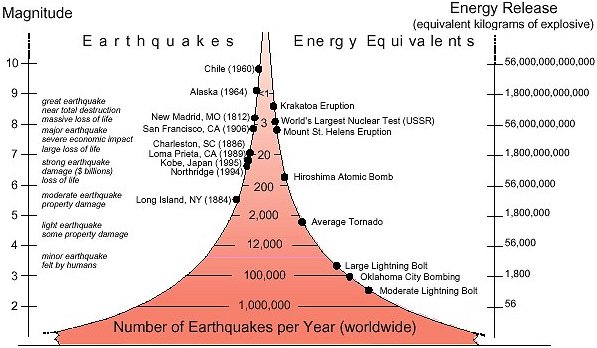
Energy of earthquakes. From [1].
An obvious question to ask is "Where does this energy come from?" Surprisingly, perhaps, with such a fundamental question, the answer has been "We're not really sure".
Of course there have been attempts at answers, as in [2]. Most come down to saying parts of the Earth are re-arranging, through gravitational forces, or the movement of "tectonic plates", and the like. This doesn't get us very far -- "movements in the Earth" are really just another way of saying "earthquakes".
What none of these answers has addressed, as far as I can determine, is the relative size or ultimate source of the energy of earthquakes. These are fundamentally important factors. Let's look at them now.
Earthquake energy in the global energy budget
By far the largest input into the Earth's energy budget, is the energy we receive from the Sun. In a previous article (Finally, the True Origin of Earthquakes? [3]), I have summarized the main components of this budget.
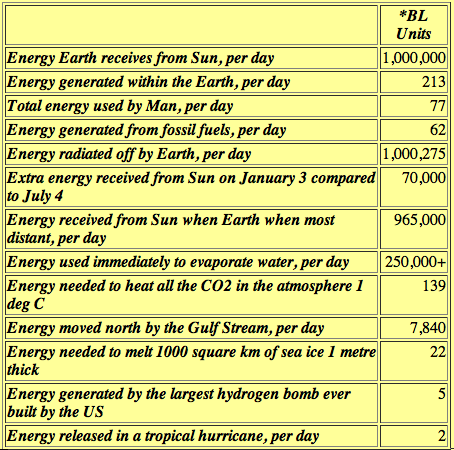
The Earth's energy budget (without earthquakes). From [3].
This budget is presented in "BL Units" (where 1 BL unit is one-millionth of the average daily energy Earth receives from the Sun), to scale things to a level easier to grasp. Items other than the solar influx, and its derivatives, are quite tiny.
The energy which we generate from fossil fuels is only 62 units per day on this scale, hugely less than the 1,000,000 units per day from the Sun. Our total daily energy use, including nuclear, wind, and photovoltaic, is only 77 units. Energy generated within the Earth, seeping up to the surface from below, is a bit higher at 213 units (these figures are admittedly estimates, but are of the right order).
However when the energy derived from earthquakes is examined, averaging 7110 units per day, this can be seen to be a major source -- the next biggest after the Sun itself. This basic factor is usually ignored in thinking about the Earth.

Contribution of earthquakes to the Earth's energy budget. From [3].
Of course, earthquake energy is not released in a regular way each day, but instead mostly in major events which may only last for a few minutes, on only a few days in the year. The 7110 units quoted is an per-day average, totalling the energy released by the million or so measurable earthquakes of all sizes per year, and dividing by 365.
No explanation of how the Earth behaves can be acceptable which does not include this energy of earthquake release. I know of only one allowable explanation to date, which is that earthquake energy stems from continuing expansion of the Earth.

Proposition TKP1. From [3].
Although it can trace its origins back to the 1830s [4], the Expanding Earth Model has only come into general acceptance over the last 30 or so years. According to this model, the Earth has been expanding in size throughout its history -- over the last 200 million years, it has approximately doubled in radius.
In the model, expansion is initiated at the Core of the Earth, and this naturally is expressed right up to the surface. But the forces do not act uniformly all over the surface, instead the planet is adjusting and equilibrating [5] to accommodate the underlying expansion, and we call the larger of these adjustments "earthquakes".
This Expanding Earth model still has its critics and disbelievers, those who deny that expansion of the Earth is occurring. But there are no critics or disbelievers who deny that earthquakes occur. As the Expanding Earth model is apparently the first to explain earthquakes, it should be adopted generally, at least until a better explanation is available.
What causes the Expansion?
To understand the cause of expansion of the Earth, we need to look at the structure of the Earth, and the nature of atoms and their parts. First we need the new model of the structure of the Earth, described in Inside The Earth -- The Heartfire Model [10].
Topic 2. Decay of compacted neutrons at the Earth's core
The Heartfire Model of the Earth is a little different from the conventional picture. In this model, the division of the Earth into 4 concentric layers is as normal -- these layers are well defined by seismic data.
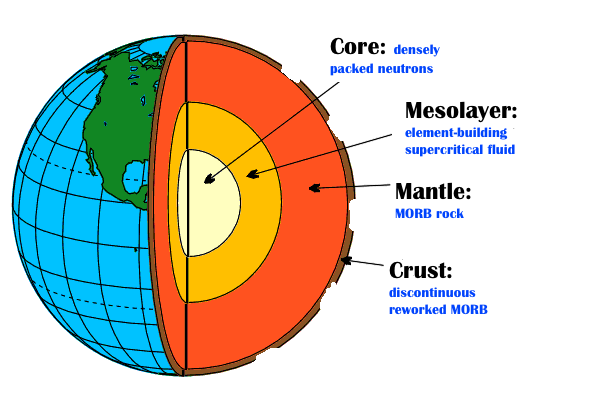
The Heartfire Model of the structure of the Earth. From [10]
For more detail on the characteristics of the layers according to this model, see [10]. Here we are concerned with the Core, the innermost layer of the planet (sometimes referred to as the Inner Core). According to Heartfire, the Core contains Compacted Neutrons, although the model does not say whether these make up all, or only part, of the Core, and if the latter, does not say how they are distributed. The important thing is that they are compacted as individual neutrons, not forming parts of conventional atoms.
As to how the compacted neutrons got there, the assertion is that they formed naturally under great pressures as the material of the Earth was first accumulated, during the birth of our Solar System. This topic is covered in more detail in The Cosmic Smog model for solar system formation, and the nature of 'Dark Matter', at [11].
We need not go into further detail of Cosmic Smog, except to note that it assumes all cosmic bodies, from the most massive stars down to the smallest asteroids, were formed by aggregation of interstellar matter under gravity (this is not at all controversial).
With increasing mass of a body, gravitational pressures lead to increasing compaction and density at the body's core, and ultimately, for bodies of about the mass or Mars and above, to breakdown of atoms to denser material, commonly called degenerate matter. It is this material which is referred to here as compacted neutrons.
While not generally recognized as existing within planets, these compacted neutrons are well-known as existing within stars, and in particular form almost all the matter within so-called "neutron stars", generally recognized as the products of massive explosions which blew off all a star's outer layers.
Neutrons and the structure of atoms
The composition of atoms is now well defined, and not in dispute here. Atoms essentially consist of three particles -- protons, electrons, and neutrons.
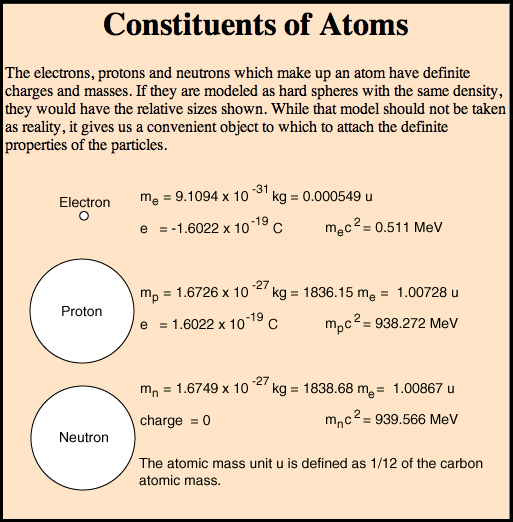
Constituents of atoms. From [9].
Protons (which have a positive charge) and neutrons (no charge) are found in the very dense nucleus of the atom. The nucleus is surrounded by electrons (negative charge), in a very light 'cloud', which is hugely larger than the nucleus -- in fact the whole atom has some 100,000 times the radius of its nucleus.
All about neutrons
Neutrons within the nucleus of an atom are classed as stable -- they do not break down or 'decay' into anything else. However, some nuclear processes can produce free neutrons, individual particles which are not part of an atom. These free neutrons do break down -- they have a half-life of just over 10 minutes.
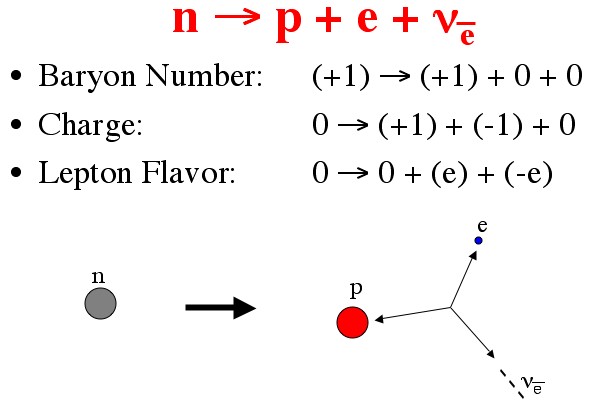
Decay of a free neutron. From [8].
Free neutrons decay into a proton, an electron, and a packet of energy. If you look at the table of Constituents of Atoms above, you can note that the combined mass of a proton and an electron is a little less than that of a neutron. It is this small difference of mass which is converted into the released energy, according to the Einstein equation, E = mc2.
Physicists have confirmed that this converted mass leads to an energy release of about 782 KeV per neutron (energies at the atomic level are usually given in thousands of electron-volts). The proton and the electron formed by the decay process combine to form a hydrogen atom. Hydrogen is the simplest element, with a nucleus containing just a proton. (All other elements have neutrons in their nuclei).
Core neutrons as the source of Earth internal heat and expansion
So we know that neutrons within an atomic nucleus are stable, they do not break down because internal forces within the nucleus prevent this. Neutrons within a neutron star are also not subject to decay, because they are held together by the immense gravitational pressures within such stars.
According to the Heartfire model, the Core of the Earth also contains compacted neutrons, produced from ordinary matter by the extremely high pressures created at the centre of the Earth at the time of its formation, some 4.7 billion years ago. Some of these neutrons, perhaps those at the periphery of the Core (where pressures are very slightly less and the neutron-compaction phase terminates), are not completely stable. A tiny proportion break down into proton + electron pairs (equivalent to hydrogen atoms), with the release of energy.
This compacted-neutron decay process explains both the expansion and the internal heat of the Earth. There have always been problems with accounting for the internal heat of the Earth -- ideas of residual heat from the time of the planet's formation, or energy from radioactive decay, do not stand up to quantitative analysis.
Above all, this model elegantly and easily explains expansion of the Earth. Neutrons in a compacted state, such as those in neutron stars, have the density of atomic nuclei, rather than of atoms -- atomic nuclei have diameters around 100,000 times those of atoms. The volumes and densities compare as the cube of 100,000, that is 1015 -- 1 followed by 15 zeros.
As an example of what these sorts of densities mean, if the all the Earth's matter existed at neutron-star density, the planet would be only about 300 metres in diameter.
According to [12], a hydrogen atom has a diameter of approximately 1.06 x 10-10 m, as defined by the diameter of the spherical electron cloud around the nucleus. The hydrogen nucleus has a diameter of approximately 2.40 x 10 -15 m. So the decay of a compacted neutron at the Core would not only release energy showing up as internal heat, it would result in a hydrogen atom many trillion times bigger than the original neutron.
Incidental evidence of planetary expansion
Some incidental evidence supporting these processes is obtained by looking at the other planets. Mars appears to have undergone expansion processes for the first billion or so years of its existence, then expansion stopped. The presumption is that it had then used up its relatively small core of compacted neutrons.
The planet Mercury and our Moon are both considerably small than Mars, and on the present model would never have had compacted-neutron cores. As expected, they show no evidence of past expansion.
Venus is almost as large as the Earth, and so would be expected to have formed quite a large compacted-neutron core. In conformity with this, it shows considerable surface activity, as expected if it, too, is expanding.
The outer planets, Jupiter and beyond, show only thick gaseous surfaces, so nothing can be presently deduced about their presumed rocky interiors. But their surface temperatures can be measured and analyzed, and these reveal something about heat flow from their interiors.
Internal heat of the planets
Here is an extract from Heat Radiated By the Planets [13].
"At the current time most of the heat once stored inside the planets has leaked to their surfaces, and been radiated away. As a result, the heat of the Sun is the primary source of heat at their surfaces. In fact for the Terrestrial planets, the heat absorbed from the Sun and the heat radiated by the planets is so nearly identical that uncertainties in the two values, small though they are, are much larger than any heat still leaking from their interiors.
For the Jovian planets, however, this is not true. Jupiter radiates nearly three times as much heat as it absorbs from sunlight, meaning that two-thirds of its surface heat budget is derived from heat leaking out of its interior.
For Saturn, heat leaking from the interior is considerably smaller than for Jupiter, but is still about half of the surface heat budget. This implies that Jupiter is still extraordinarily hot inside, and Saturn, though not as hot as Jupiter, is probably twice as hot (in the deep interior) as the Earth.
For Uranus and Neptune the heat flow from the interior is much smaller, and they probably have lower internal temperatures than the Earth, but not as much lower as might have been thought forty or fifty years ago."
The picture described above fits in well with the compacted-neutron approach. Jupiter is easily the most massive of the planets, and would be expected to have formed a very large compacted-neutron core. Saturn, the next most massive planet, would be expected to have a somewhat smaller core, and hence have a lower heat production from decaying neutrons than does Jupiter.
Neutrons in neutron stars
It was noted above that the accepted mode of production of neutron stars, which consist almost entirely of compacted neutrons, is that they were left when stars lost all their outer layers through massive explosions.
Implicit in this view is the fact that the original stars must have had massive compacted-neutron cores before they exploded, as there is no suggestion that these cores were formed by the explosions.
In fact, it seems reasonable to assume that all stars (including our Sun) have compacted-neutron cores, formed at the time they first aggregated out of interstellar matter.
Conclusions and outlook
This article presents models which explain two of the most puzzling aspects of the Earth -- what causes earthquakes, and why the Earth is expanding. The rational scientific approach is that these models should be accepted, unless they can be proven wrong (not matching with reality), or replaced with something better. Over to you.
* * * * * * * * * * * * * * * * * * * * * * * *

References and Links
1. How Often Do Earthquakes Occur? http://www.mgs.md.gov/seismic/education/no3.html .
2. Where does the energy of earthquakes come from? https://answers.yahoo.com/question/index?qid=20110324123303AAZde8v .
3. Finally, the True Origin of Earthquakes? http://www.aoi.com.au/bcw1/Finally/index.htm .
4. Fixed-Earth and Expanding-Earth Theories -- Time for a Paradigm Shift? http://www.aoi.com.au/bcw/FixedorExpandingEarth.htm .
5. How Seafloor Spreading affects the level of oceans and seas -- The Expansion Equilibration Model. http://www.aoi.com.au/bcw/Seafloor/index.htm .
6. An electron and a proton can not form a neutron because they are short about 800KeV of energy. https://www.physicsforums.com/threads/an-electron-and-a-proton-can-not-form-a-neutron-because-they-are-short.
7. Neutron. https://en.wikipedia.org/wiki/Neutron .
8. Is it true that all matter is simply condensed energy? http://www.askamathematician.com/2010/01/q-is-it-true-that-all-matter-is-simply-condensed-energy/ .
9. Constituents of Atoms. http://hyperphysics.phy-astr.gsu.edu/hbase/chemical/atom.html .
10. Inside The Earth -- The Heartfire Model. http://www.aoi.com.au/bcw/Heartfire/index.htm .
11. The Cosmic Smog model for solar system formation, and the nature of 'Dark Matter'. http://www.aoi.com.au/bcw1/Cosmic/index.htm .
12. Hydrogen atom vs hydrogen nucleus. https://www.physicsforums.com/threads/hydrogen-atom-vs-hydrogen-nucleus.379349/ .
13. The Internal Temperatures and Magnetic Fields of the Planets. http://cseligman.com/text/planets/magnetism.htm .
Go to the AOI Home Page
Draft version 1.0, 2015 Jul 6.
First version 1.1 on Web, 2015 Jul 12.









